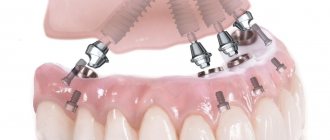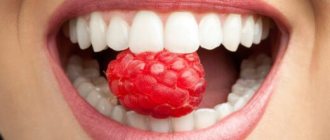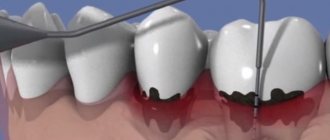Periodontal disease is a disease in which there are systemic lesions of the tissues around the tooth, that is, the periodontium. This disease also causes progressive damage to the dental cells (alveolar processes), sclerotic changes, the appearance of a fine-mesh pattern and a decrease in bone mass.
Periodontal disease refers to the last stage of damage to periodontal and gum tissues. Alveolar pyorrhea at the initial stage has no clinical manifestations and develops slowly. There are three stages during which different symptoms appear.
First stage of periodontal disease
At the first stage, degeneration of the alveolar processes is observed, which is accompanied by itching and burning in the gums, the appearance of persistent plaque, and increased sensitivity. There are no visible pathologies or inflammatory processes, but the teeth do not hurt or become loose.
The initial stage is also characterized by a burning sensation in the mucous membrane of the gums, which ceases to receive a normal supply of nutrients. This period is the most favorable for conservative treatment (not requiring surgical intervention).
Timely measures can minimize the consequences of the disease and prevent the transition to the second and third stages. At this stage, the teeth are firmly held, there are no gaps between them, and there is no exposure of the cervix. There is also no bleeding yet, but there is already tartar, which, even with regular professional cleaning, quickly accumulates again.
Unfortunately, the practically asymptomatic course causes the lack of early diagnosis. The disease occurs without itching and pain.
Is it possible to perform curettage at the site of an extracted tooth?
Curettage of the socket of an extracted tooth - what is it? This process is similar to what is done when the tooth is still intact. After the tooth is removed, the dentist removes the affected tissue.
This process is carried out if suppuration begins at the site of the tooth, crumbs from hard tissue remain, alveolitis begins to form, or there are signs of necrosis of the walls.
The dentist performs a curettage, after which the wound is closed with a tampon. The process may often be required if, after tooth extraction, the patient behaved incorrectly and the wound did not heal as required.
Another common indication is the appearance of dry socket syndrome. It can lead to alveolitis and the fact that the area will not heal for a long time with all the ensuing dangerous consequences.
Typically, patients themselves are rarely able to determine that they have a problem. Therefore, it is important to be sure to come to the doctor on schedule in order to monitor how tissue restoration is progressing after surgery.
The process itself consists of 5 stages:
- The treatment site is anesthetized so that the patient does not feel anything. Both infiltration and conduction anesthesia are used.
- Washing the hole. All foreign matter is removed, including blood, food debris, and pus.
- Cleaning the tissue walls and the hole itself. This is a direct curettage that requires close attention from the dentist.
- Antiseptic treatment. This is necessary to prevent the spread of bacteria.
- Closing the wound. The doctor applies a bandage. This allows you to stimulate wound healing and reduce the likelihood of resumption of the inflammatory process.
Since the area is treated from all potential threats, the tissue begins to heal quite quickly, and the risk of alveolitis recedes.
Second stage of periodontal disease
At the second stage, degenerative processes are observed, provoking the release of pus in the gum pockets, the development of bleeding, and pronounced periodic gingivitis. A purulent process develops in the cavity of the pockets, the gum structure becomes loose, a whitish coating appears and the pericervical area is exposed. Gradually, tooth mobility and cracks in which food accumulates appear. There is pain when biting.
The middle stage indicates the development of periodontal disease, the roots are exposed by approximately 40-50%, interdental spaces and gum pockets are formed. Inflammatory processes periodically appear in the pockets with the release of pus.
Periodontal pocket: what is it?
Due to the inflammatory process, bone tissue is destroyed and gradually replaced by granulation tissue. The latter mainly consists of osteoclasts and microbial cells, which, gradually expanding their “habitat” zone, lead to even more active bone atrophy. Against the background of such “events”, a violation of the ligament between the tooth and gum occurs.
As a result, a periodontal or periodontal pocket is formed. It is a space equal in size to the area of destroyed bone and filled with granulation tissue, purulent masses, and food debris. Such a pocket is diagnosed in one of the following ways:
- using x-rays. Bone atrophy is determined by the presence of darkening in the image;
- periodontal probe. Normally, the probe penetrates under the gums by 1-2 mm; exceeding this indicator indicates a gum pocket.
Lack of treatment leads to further deepening of periodontal pockets, as a result of which the teeth sooner or later take a “fan” position. It should be noted that folk remedies not agreed with the doctor in this case are not considered treatment.
The third stage of periodontal disease
This stage indicates the appearance of tangible atrophy of a total nature, the necks are greatly exposed and there is a strong displacement and instability of the tooth. The pain is constant and aching, abscesses are private, gum pockets become large and deep. In the absence of appropriate treatment, tooth loss occurs (the process spreads to the entire jaw), and osteomyelitis develops.
At the last stage, also called acute, serious deterioration of the condition is observed. Typically, patients consult a doctor precisely during this period, when pain, inflammation, and pus discharge appear. Severe exacerbation is possible during the dystrophic-inflammatory form, combined with the generalized form. Severe cavity abscesses are observed, and general intoxication due to purulent accumulations is possible. This period is characterized by a rapid course, the result of the acute stage is tooth loss.
Are there complications?
The procedure is safe and is carried out in strict compliance with all technology requirements.
But there are several potential problems that may arise as a result of personal characteristics of the body or non-compliance with requirements during the rehabilitation period.
These include the following:
- Sensitivity to food temperature . It occurs in almost everyone, but goes away over time. The maximum duration of hyperesthesia is up to two months. To cope with the problem, you can use special gels, ointments, toothpastes and rinses - the dentist will advise which ones.
- Swelling and hematoma . They may not go away for up to two weeks, but do not pose a serious danger.
- Problems in the functioning of the facial muscles . You should not be afraid of such a manifestation, because it will pass in about 10 days. Some patients complain of difficulty opening the mouth, but this also resolves in no more than 12 days, more often earlier.
- Increased tooth mobility . Observed for up to three weeks. For this reason, you need to pay attention again to your diet and remove foods that are too hard.
The patient's condition is constantly monitored by an experienced dentist, so that any serious complications can be avoided.
Other forms of periodontal disease
In rare cases, neurodystrophic damage to pain receptors is observed, accompanied by the following phenomena:
- exposure of the neck and root of the tooth in the absence of inflammation or visible swelling;
- there is no acute pain, but there are wedge-shaped defects;
- tartar is observed (no plaque);
- there are no cavity pockets or their depth is small;
- The tooth stability is excellent, but only in the first two stages.
The chronic form is the most common; it is a long, sluggish process without pain or obvious symptoms. Often there are no signs at all, which subsequently causes complex treatment. In most cases, cure will require lifelong measures, otherwise the overall condition of the gums and teeth will deteriorate sharply. The result is a dystrophic process.
One more form stands out - neglected. The development time spans decades, the process is not accompanied by pain, inflammation, and there are no clinical symptoms. Signs of the stage are axial separation of teeth, large gaps, movement of individual teeth, ligament degeneration, and systemic dystrophy.
Treatment for this form is long, often very painful, and requires splinting. Measures are also needed to strengthen tissues and restore blood circulation in the periodontium.
Indications and contraindications for curettage
Closed curettage is prescribed in the initial stages of periodontitis and the depth of the cavities is no more than 3-4 mm. At the same time, the soft tissues retain a dense structure without signs of atrophy, although quite large accumulations of hard deposits are present under the gums.
Open periodontal cleansing will be optimal for treatment in the following cases:
- The presence of voluminous pockets in the periodontium with a depth of more than 5 mm.
- Severe symptoms of periodontal disease and periodontitis.
- Atrophy of bone tissue at the roots and its replacement with granulations.
- Pathological mobility of teeth.
But not everyone can undergo the procedure. There are situations when its use is contraindicated because it can aggravate the course of the disease or there is a high risk of complications. These include:
- Copious purulent discharge from the gingival cavity.
- Serious malocclusion and tooth position.
- Infectious diseases.
- Inability to administer anesthesia (allergy to the drug, mental illness).
- Blood clotting disorders.
Most of the contraindications are temporary and fairly easily removable. For example, if purulent discharge is detected, antibiotic therapy is first carried out, after its successful completion it becomes possible to clean the periodontal pockets.
Dentistry
Causes of periodontal disease
The main reasons that lead to the appearance of periodontal disease:
- disruption of the endocrine system;
- bone tissue injuries;
- lack of vitamins, in particular vitamin C;
- problems with the gastrointestinal tract, cardiovascular system;
- smoking, alcohol abuse;
- hereditary factor;
- the presence of malocclusion (chronic injuries to the mucous membrane);
- taking anticonvulsants;
- the presence of chronic diseases, including diabetes mellitus, hypertension, dystrophic neurogenic processes, atherosclerosis, hypoxia;
- physical inactivity;
- impaired blood circulation in tissues;
- improper dental care.
The exact list of causes of periodontal disease has not been fully established. Much depends on heredity, the functioning of the cardiovascular and endocrine systems, and the presence of diseases of internal organs.
It is impossible to become infected with periodontal disease, since this disease is not caused by viruses or microbes. Bed linen, dishes, cutlery, and kisses cannot cause disease transmission. But personal hygiene should still be given maximum attention, since one of the reasons for the development of lesions is precisely damage to the mucous membrane of the gums and bone tissue.
Factors provoking the development of the disease
- Poor oral hygiene
- Presence of dental plaque (regardless of the reason for its formation)
- Lack of vitamins and minerals in the body
- Progressive dental diseases
- Bite defects
- Hereditary factor
- Metabolic disease
- Sharp changes in hormonal levels (pregnancy, menopause)
- Decreased bone strength
- Diabetes mellitus and other pathologies of the endocrine system
- Oncology
- Severe liver or kidney damage
- Atherosclerosis
- Nervous system diseases
- Excessive smoking
- Unbalanced diet
Important: periodontists recommend that patients with a history of even one of the listed factors regularly (at least twice a year) come to the dental clinic for a preventive examination. Early detection of the disease will reduce treatment time and save costs.
Symptoms and signs of periodontal disease
There are no specific symptoms of periodontal disease, but there are signs that indicate problems have arisen and may indicate damage to the bone tissue of the tooth. But there are a number of basic symptoms that indicate the beginning of problems and the need to visit a doctor. Such signs include mobility and gaps between teeth, the appearance of bacterial plaque, periodontal pockets, pus, swelling and swelling of the gums. It should also be remembered that the oral cavity requires constant care, but if an unpleasant odor and the listed symptoms occur during regular cleaning, this indicates a developing disease.
Symptoms of periodontal disease include the following:
- the gums appear pale, and in the early stages there are no obvious inflammatory processes;
- Retraction of the gums appears, the neck is exposed, visually the length of the tooth seems longer;
- there is no bleeding in the early stages, but purulent pockets, enamel erosion, wedge-shaped defects and tooth abrasion may appear;
- At the same time, problems with the endocrine system, diseases of the cardiovascular system, and metabolic disorders can be diagnosed.
Main features
It is important to remember that at the initial stage there are no specific signs; alveolar pyorrhea often develops asymptomatically. Therefore, the first signs are already indicators of degenerative processes and require urgent intervention from a specialist. Pain, atypical plaque, softening of the gums - all this indicates the need to see a dentist and undergo examination with subsequent treatment.
The main signs of periodontal disease are:
- the appearance of atypical plaque in large quantities (this is not a specific sign, but already indicates the presence of problems);
- the appearance of tartar;
- discomfort when eating cold/hot, spicy food;
- itchy gums;
- the appearance of pulsation in the gum area;
- purulent discharge;
- bleeding in the gum area when chewing or other mechanical impact on their surface;
- the appearance of defects such as cavities, pockets or crevices in which food begins to accumulate;
- the gums begin to become covered with a whitish coating;
- teeth become weak, gaps appear between them, abrasion and other defects appear on the surface;
- the necks are exposed, the teeth visually appear longer;
- There is a phenomenon called retraction (destruction, resorption) of the gums.
Treatment of periodontitis
The disease requires urgent intervention by a dentist. Treatment of periodontitis includes non-surgical and surgical methods. The first (professional hygiene) is used in the early stages of the disease and for prevention. They consist of removing tartar (mechanically and ultrasound) and polishing the tooth surface, followed by treating the crown and root of the tooth with special brushes with fluoride-containing protective varnish.
There is a procedure for removing deep tartar called curettage: the doctor removes deposits using special hooks, excavators, curettes (closed curettage), or, if surgery is required, by cutting the gums (open curettage). The goal of surgical methods is to eliminate gum pockets (a consequence of bone tissue resorption) so that the tooth regains stability.
Diagnosis of periodontal disease
Diagnosis of periodontal disease begins with a visual examination, and the first signs of the problem are excessive formation of tartar with atypical exposure of the upper peri-cervical part of the teeth. It is recommended to go to the doctor for an emergency examination in the following cases:
- exposure of the neck or root of the teeth with the absence of severe inflammation;
- gum retraction;
- the presence of periodontal (gum) pockets;
- violation of the inclination of the teeth, the appearance of gaps;
- diagnosing metabolic disorders, problems with the endocrine or cardiovascular system.
Diagnostic methods
It is necessary to understand that a disease such as periodontal disease leads to extremely negative consequences. This is atrophy of the tissues of the mucous membrane of the gums and periodontium, the appearance of side diseases of the jaw, and loss of teeth. Therefore, it is necessary to consult a doctor regularly, and not only when the disease reaches an advanced stage. This will prevent the problem, diagnose periodontal disease at an early stage, start treatment in a timely manner and save teeth.
Diagnosis of periodontal disease includes the following measures:
- biochemical, general blood tests;
- assessment of the state of the immune system (an immunogram is prescribed);
- study of leukocyte vitality;
- Rotter's test to study the saturation of the body with vitamin C (deficiency of this substance is one of the causes of tooth loss);
- diagnostics of proteolysis activity, that is, the process of protein decomposition in the body into enzymes;
- microbiological methods;
- smears, impressions of the oral cavity (taken from the surface of the mucous membrane).
Typically, a diagnosis of periodontal disease is prescribed by a dental therapist after a visit. The patient is referred to a periodontist if there are signs of periodontal disease, the specialist performs a visual examination and further measures are prescribed. X-rays are often required to show the general condition of the teeth, see what form the tissues are in and how deep the lesions are. Treatment is prescribed based on the results of the study; its methods can be different, depending on the degree of damage to the teeth and gums.
Consequences
The ongoing inflammatory process associated with soreness and inflammation of the gums contributes to the development of periodontitis, which results in the formation of so-called pockets between the teeth and gums, where numerous bacteria accumulate. If this condition is not stopped, deep infections occur, subsequently causing irreversible processes, including loss of bone tissue and teeth.
Ongoing chronic inflammation can put a strain on your immune system, and bacteria, entering the bloodstream through the gum tissue, have a negative impact on the functioning of the heart and lungs. The above conditions sometimes cause frequent respiratory diseases and rheumatoid arthritis.
Treatment and prevention of periodontal disease
Treatment of periodontal disease is a long process that requires the patient to strictly adhere to the recommendations and prescriptions of the doctor. Measures to get rid of periodontal disease can be different, it all depends on the stage and how far the damage to the gums and dental tissues has progressed.
The following methods are used in treatment:
- physiotherapy;
- surgical treatment (curettage of periodontal pockets);
- splinting (for loose teeth)
- anti-inflammatory treatment;
- preventive measures (aimed at preventing the development of periodontal disease and its more complex stages, and are also used to normalize the condition of dental tissue).
The main set of measures is aimed at restoring and improving gum blood flow, reducing pain, and inflammation of periodontal tissue. Correct and timely treatment restores the normal supply of tissues with oxygen and nutrients, and allows you to stimulate the formation of new cells.
Physiotherapy
Physiotherapeutic treatment includes:
- ultrasonic treatment of the oral cavity;
- electrophoresis;
- KUF therapy.
Such treatment methods help improve the blood supply to the gum tissue and the general condition of the periodontium.
Why is curettage of periodontal pockets necessary?
There is a practice when, to get rid of periodontitis, they do not go through surgery, but limit themselves to taking antibiotics, removing dental plaque, using a laser or local anti-inflammatory therapy. But such steps are more likely an attempt to cure the disease than a truly effective remedy for periodontitis. For what reasons may such therapy not work?
- If the periodontal pocket is very deep, then it is impossible to completely clean it of deposits with ultrasound. The procedure is carried out blindly: the dentist “feels” with the attachment under the gum, but does not see what is happening there. Therefore, even after the highest quality cleaning, there remains a possibility that some amount of subgingival stone remains in its place.
- Anti-inflammatory therapy and cleaning of subgingival deposits cannot guarantee that periodontitis will stop, since a favorable “climate” for the development of infection still remains.
This is why most doctors strongly advise patients to undergo surgery. Only surgical intervention can get rid of all the problems associated with periodontitis, namely:
- remove granulations;
- remove gum pockets;
- remove deposits from under the gums.
Among the most popular surgical methods for treating periodontal diseases is curettage of periodontal pockets. If necessary, it can also be used for periodontal disease and gingivitis.
Prevention of periodontal disease
Prevention of a disease such as periodontal disease should include a whole range of measures, including eating healthy, fortified foods, regular oral care, and visiting the dentist. You need to start with regular intake of microelements. You should first consult with a supervising physician, who can correctly assess the degree of mineral deficiency and advise taking supplements or following a diet. Such prevention will allow you to saturate the body with essential microelements and quickly restore tissue.
In addition, patients with periodontal disease should regularly visit their doctor and maintain oral hygiene:
- Teeth should be brushed twice a day, recommended after each meal;
- To clean the interdental space, you need to use a special dental floss;
- follow a special balanced diet;
- after eating, rinse with special antiseptic rinses;
- use toothpastes with an anti-inflammatory effect.
Periodontal disease also requires regular professional tartar removal, performed by a supervising physician. In this case, tartar will not have time to accumulate in a large volume, the gums will not be injured, which will speed up the cure of the disease and prevent the development of such a dangerous disease as periodontal disease.
What can a doctor do?
Only the dentist and hygienist with a simple examination
can determine the presence or absence of periodontal disease. The essence of the study is to measure the periodontal pocket (for periodontitis) using a special probe and an x-ray. This method allows the doctor to quickly and painlessly assess the condition of your gums, propose a treatment plan to prevent further development of the disease, and develop a special self-hygiene regimen that will suit your specific situation.











